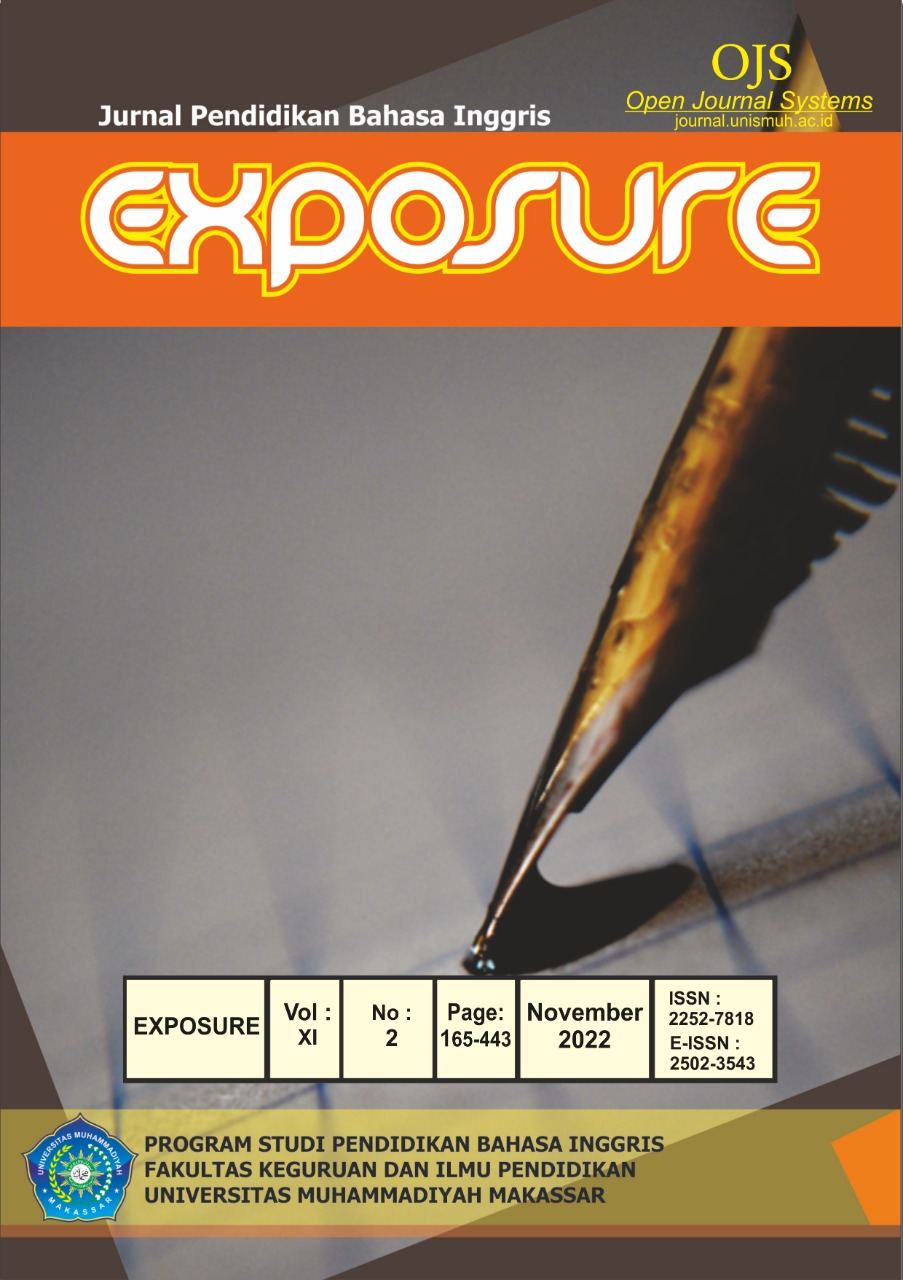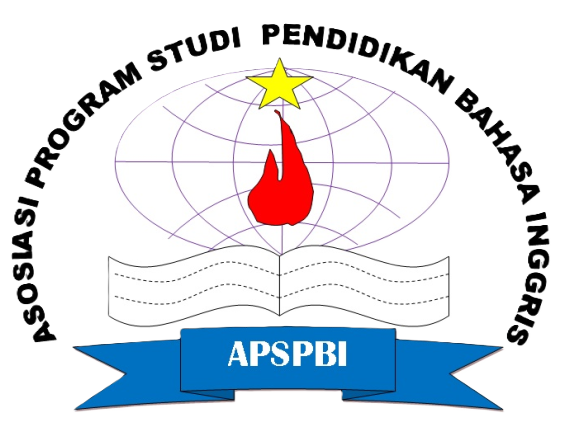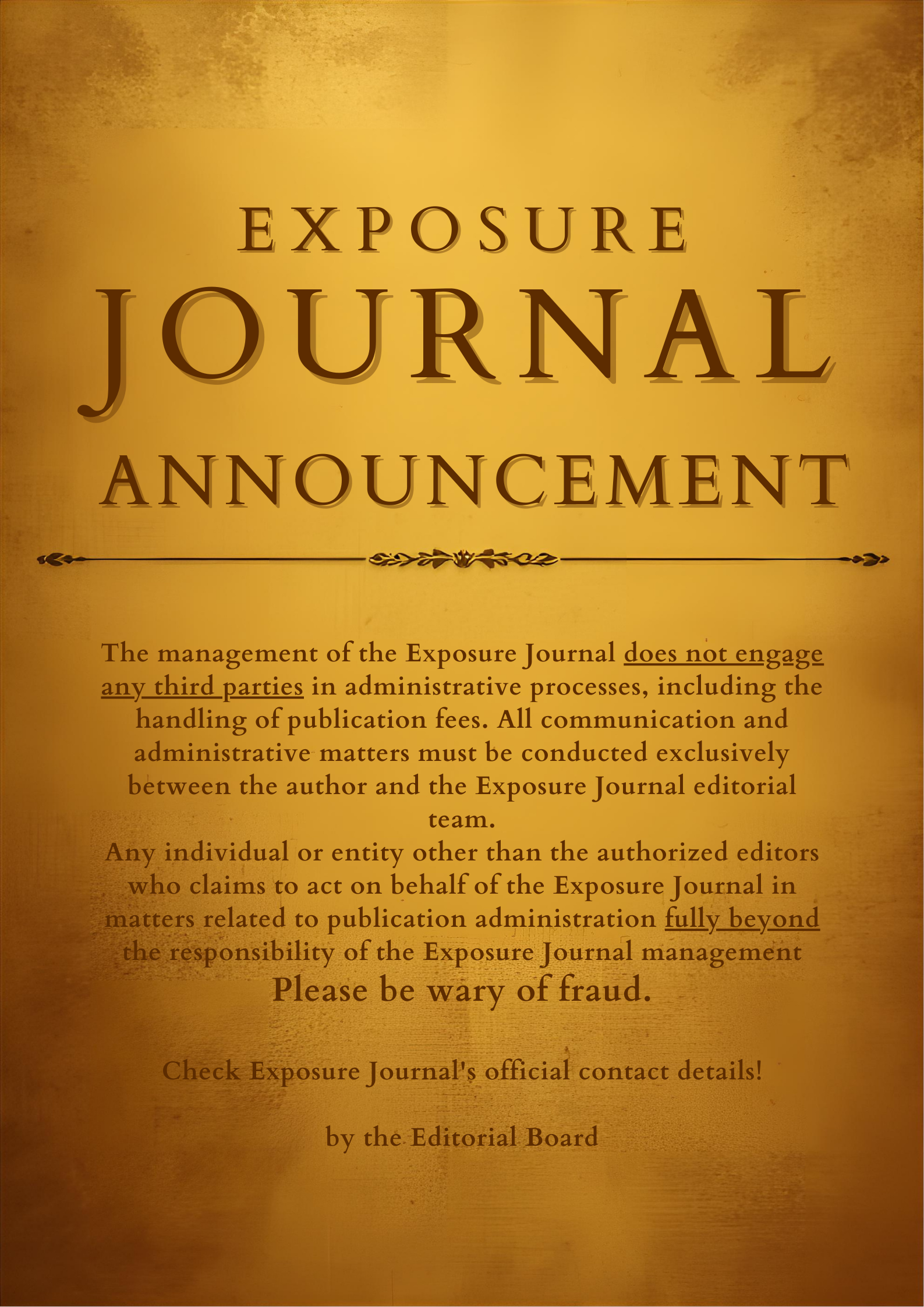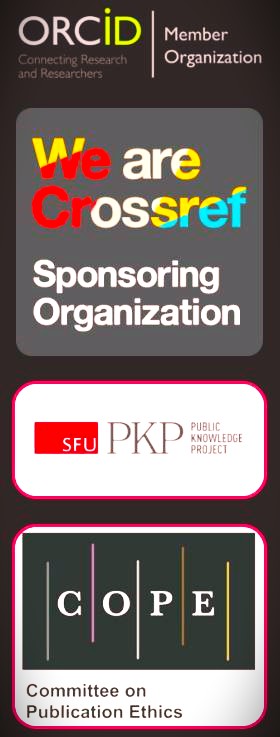THE STUDENT’S ACCURACY IN USING DISCOURSE MARKERS FOR ACADEMIC WRITING (A CASE STUDY OF STUDENTS IN ENGLISH AND LITERATURE DEPARTMENT
DOI: https://doi.org/10.26618/exposure.v11i2.8728
Discourse Markers, Academic Writing, Student’s Accuracy
Abstract
This research focused on the accuracy of discourse markers used by the students in their academic writing, especially in the thesis background. This research used a qualitative method, analyzed by Bruce Fraser (1999) to identify the elaborative markers. The result of data analysis in this research found the types of discourse markers used in students’ thesis background, which are: the first is contrastive markers such as whereas, otherwise, even though, in contrast, and yet. The second is elaborative markers such as besides, in other words, also, for example, furthermore, and. The last is inferential markers such as so, because, in this case, hence, therefore, then, and in this case. On that basis, the dominant type of discourse markers used in students’ thesis background was elaborative markers which were applied about 11 times. In addition, the researcher found there were 20 discourse markers that were used in the student’s thesis background. The result of this research showed that only 16 of the discourse markers were used in an appropriate way and 4 of them were used in an inappropriate wayReferences
Aidinlou, N. A. (2012). The Effect of Discourse Markers Instruction on EFL Learners ’ Writing. World Journal of Education, 2(2), 10–16. https://doi.org/10.5430/wje.v2n2p10.
Al-khazraji, A. (2019). Analysis of Discourse Markers in Essays Writing in ESL Classroom. International Journal of Instruction, 12(2), 559–572. https://eric.ed.gov/?id=EJ1211008.
ALAHMED, S., MOHAMMED, Y., & KIRMIZI, Ö. (2020). The use of discourse markers in L2 English writing by Iraqi postgraduate students at Karabuk University. Eurasian Journal of English Language and Literature, 2(1), 107–115.
Bhatia, V. K. (2002). Applied Genre Analysis : A Multi-Perspective Model. Journal of the European Association of Language for Specific Purposes (AELFE), 4, 3–19. https://www.google.co.id/url sa=t&source=web&rct=j&url=http://www.aelfe.org/documents/text4Bhatia.pdf&ved=2ahUKEwjr5NWqrdDxAhUljuYKHWWOAwEQFjACegQ IBRAC&usg=AOvVaw3toXWqeUuOFXjQ7rqIsjHs
Dulger, O. (2007). Discourse Markers in Writing. Journal on Studies in English Language, 18, 257–270. https://www.google.com/url?sa=t&source=web&rct=j&url=https://citeseerx.ist.psu.edu/viewdoc/download?doi=10.1.1.505.5703&rep=rep1&type=pdf&v ed=2ahUKEwjwiOrZr8_xAhUrlEsFHb_3CHQQFjACegQIChAC&usg=AO vVaw2lqkzPgvzfgtUTE_qdfMDA.
Fraser, B. (1999). What are discourse markers ? Journal of Pragmatics, 2166, 931–952. https://doi.org/10.1016/S0378-2166(98)00101-5.
Fraser, B. (2009). An approach to discourse markers An Account of Discourse Markers. International Review of Pragmatics, 2166(October), 293–320. https://doi.org/10.1016/0378-2166(90)90096-V.
Jalilifar, A. (2009). Discourse Markers in Composition Writings : The Case of Iranian Learners of English as a Foreign Language. English Language Teaching, 1(2), 144–122. https://doi.org/10.5539/elt.v1n2p114
Jones, R. H. (2012). Discourse Analysis: A Resource Book for Students. Routledge. https://doi.org/10.1163/26659077-02203007
Jordan, R. R. (2003). Academic Writing Discourse (Third). Bluestone Press. Paltridge, B. (2012). Discourse Analysis: An Introduction (2nd ed.). Bloomsbury Academic.
Ramadan, N. I. (2018). Ministry of Higher Education and Scientific Research The Libyan Academy for Graduate Studies-Misurata Branch Problems in Using English Written Discourse Markers by Libyan EFL Undergraduate Students A Dissertation Submitted to the Department of English.
Richards, J. C., & Renandya, W. A. (2002). Methodology in Language Teaching (First). Cambridge University Press.
Schiffrin, D., Tannen, D., & Hamilton, H. E. (2001). The Handbook of Discourse Analysis. Blackwell Publishers.
Sudrajat, D. (2013). Discourse Markers on Essay Writing of the Fifth Semester Students of English Department of Kutai Kartanegara University Didi Sudrajat. Journal of Education and Learning, 1(2), 1–10.https://ejurnal.unikarta.ac.id/index.php/cemerlang/article/view/31
Susanto, D. A., Mujiyanto, J., Bharati, D. A. L., & Sutopo, D. (2019). The Use and Functions of English Discourse Markers (EDMs) in EFL Students Writing at University in Indonesia. 343(Icas), 67–70. https://doi.org/10.2991/icas-19.2019.14
Taylor, G. (2009). A Student’s Writing Guide: How to Plan and Write Successful Essays. Cambridge University Press.
Taylor, S. (2013). What is Discourse Markers? Bloomsbury Academic. https://www.google.co.id/books/edition/What_is_Discourse_Analysis/pITjB AAAQBAJhl=id&gbpv=1&dq=what+is+discourse+analysis&printsec=fron tcover.
Weissberg, R., & Buker, S. (2010). Writing Up Research (p. 28). Prentice Hall Regents.
Downloads
Published
How to Cite
Issue
Section
License
Authors who publish with this journal agree to the following terms:
In order to assure the highest standards for published articles, a peer review policy is applied. In pursue of the compliance with academic standards, all parties involved in the publishing process (the authors, the editors and the editorial board and the reviewers) agree to meet the responsibilities stated below in accordance to the Journal publication ethics and malpractice statement.
Duties of Authors:
- The author(s) warrant that the submitted article is an original work, which has not been previously published, and that they have obtained an agreement from any co-author(s) prior to the manuscript’s submission;
- The author(s) should not submit articles describing essentially the same research to more than one journal;
- The authors(s) make certain that the manuscript meets the terms of the Manuscript Submission Guideline regarding appropriate academic citation and that no copyright infringement occurs;
- The authors(s) should inform the editors about any conflict of interests and report any errors they subsequently, discover in their manuscript.
Duties of Editors and the Editorial Board:
- The editors, together with the editorial board, are responsible for deciding upon the publication or rejection of the submitted manuscripts based only on their originality, significance, and relevance to the domains of the journal;
- The editors evaluate the manuscripts compliance with academic criteria, the domains of the journal and the guidelines;
- The editors must at all times respect the confidentiality of any information pertaining to the submitted manuscripts;
- The editors assign the review of each manuscript to two reviewers chosen according to their domains of expertise. The editors must take into account any conflict of interest reported by the authors and the reviewers.
- The editors must ensure that the comments and recommendations of the reviewers are sent to the author(s) in due time and that the manuscripts are returned to the editors, who take the final decision to publish them or not.
Authors are permitted and encouraged to post online a pre-publication manuscript (but not the Publisher’s final formatted PDF version of the Work) in institutional repositories or on their Websites prior to and during the submission process, as it can lead to productive exchanges, as well as earlier and greater citation of published work (see The Effect of Open Access). Any such posting made before acceptance and publication of the Work shall be updated upon publication to include a reference to the Publisher-assigned DOI (Digital Object Identifier) and a link to the online abstract for the final published Work in the Journal.














